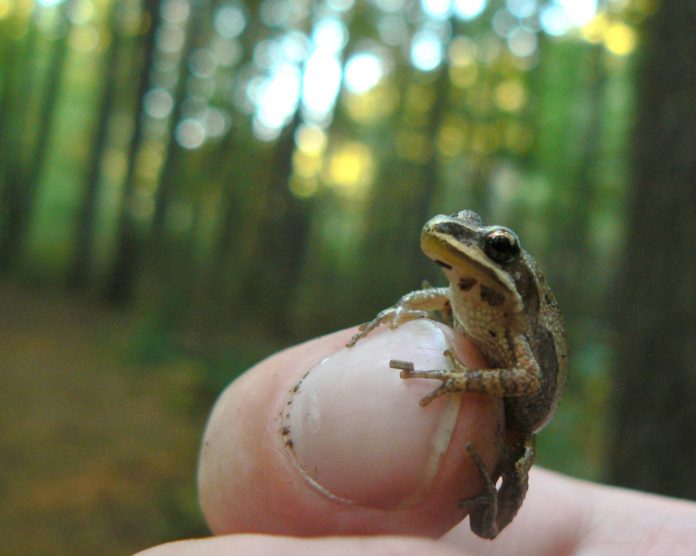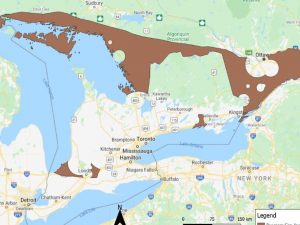
An environmental group is seeking volunteers in Muskoka to conduct surveys and fill gaps in their data with the goal of helping Ontario’s frog population.
Blazing Star Environmental partnered with Environment and Climate Change Canada and Trent University in 2020 to create a long-term monitoring program for western chorus frogs. The small tree frogs are a threatened species in Canada and have experienced ongoing population declines, so the data collected through the program will be used to assist in the recovery of the species going forward. Siobhan Galway, a terrestrial and wetland ecologist at Blazing Star Environmental, said data from the Muskoka region is extremely valuable because there haven’t been many surveys conducted north of Barrie.
“We don’t actually know if the frogs are in that area or whether they just haven’t been surveyed, so they could be there and we just don’t know about it, or they might not be in that area at all,” Galway said. “That’s something that’s really interesting about this program is that the volunteers actually have an opportunity to sort of be on the frontline of data collection and making discoveries that, right now, we still don’t know that much about at all.”
Volunteers from the Greater Toronto Area have been able to cover most of the southern portion of the range, but between smaller populations and rugged terrain, only a handful of people from the northern portion of the range have volunteered.

Since those volunteers can’t survey the rest of the range themselves, Blazing Star is hoping to bring on additional help for the last year of surveys before a five-year break in data collection. Galway said one good thing about the program is that volunteers don’t need any prior experience or knowledge about frogs. The main quality of a good volunteer is a love for the outdoors.
“You really just need a passion for nature and a willingness to learn about the frogs and learn about new things,” she said. “One of the great things about volunteer programs is that you learn so much and you really appreciate the world that we are living in even more because of it.”
Volunteers are asked to conduct five-minute auditory surveys three times at each site during the calling period, which runs from March to early June. Participants are able to choose the distance they’re willing to travel and the number of sites they want to survey. Even if volunteers only survey one site, the data they collect still makes a difference, Galway said.
To conduct the surveys, volunteers receive coordinates from Blazing Star that they can enter into Google Maps to locate their sites, which are all roadside. Once at the site, volunteers simply listen for frogs for about five minutes while recording other details like air temperature, wind speed and background noise. Each site must be surveyed three times in a two- to three-week period and Blazing Star offers a variety of resources to help their volunteers along the way.
“One of the things that we really wanted to achieve when we made this program was that we wanted to really get our volunteers comfortable and confident in their frog ID skills, and so we developed a number of resources to do exactly that,” Galway said. “The biggest one I would say is we created a frog ID quiz.”
Though some frog ID tools simply play short clips of frog calls, the team at Blazing Star designed their quiz to mimic what volunteers hear out in the wild. Multiple species are often calling at once, some loud and some quiet, so the quiz reflects that and uses a series of questions to help participants learn the calls.

Blazing Star also offers webinars and a website that acts as a central hub for everything volunteers need. It includes training materials and other program resources such as a data submission portal. Beyond the online assets, the team at Blazing Star is available to answer any questions from their participants.
Since there will be a five-year break between collection periods, this year’s efforts represent the last year of field surveys for the program’s first collection period. After the surveys are complete, the three years of data will be analyzed to determine the distribution of the western chorus frog before researchers make recommendations on how to help the species.
“Thanks to our volunteers, we’ve collected so much important information and I can’t wait to see what the results actually yield,” Galway said. “It’s a project that I’ve been working on for four years now, so seeing it come to an end, it’s very rewarding but definitely a surreal experience. With that, though, we are looking forward to working with species in the future and using the information that we’ve collected to help the species in the long run.”
Watch the webinar below to learn more about the program. To get involved, visit the Blazing Star Environmental website.







